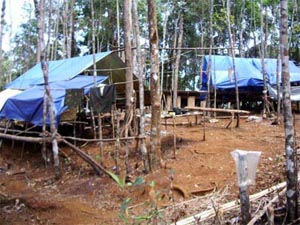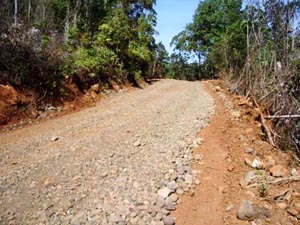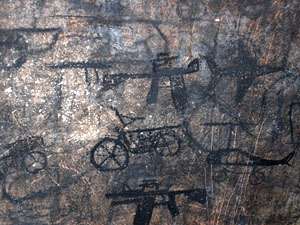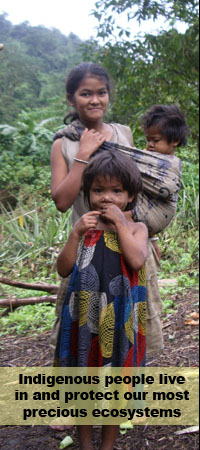|
Endangered Species International has a unique and strong relationship with indigenous people. Their ancestral lands is home of an incredible cultural and biological diversity. We believe strongly in empowering indigenous people and communities towards sustainable livelihoods, environmental justice, protecting their lands, and maintaining their traditions. Endangered Species International continuously develops research and conservation actions that totally integrate and benefit indigenous people.
The indigenous peoples from the Island of Palawan in southern Philippines have deeply suffered from displacement, deculturation (loss of culture), acculturation (replacement of one’s own culture with another’s) and impoverishment. They live in the forest where most endangered, threatened and endemic species occur. During our recent conservation activities in the Philippines, we sadly observed that the ancestral caves of the Pala’wan indigenous people have been damaged by outsiders. The uncontrolled inflow of outsiders into the land of the Pala’wan is becoming an increasing threat to the well being of their communities. ESI is taking the urgent initiative to restore the ancestral caves; those caves are used for spiritual and sheltering place during the rainy season and storm events; at the mean time, we are launching an educational program at local schools to encourage respect of indigenous people. Finally, we will find sustainable ways to reduce significantly the inflow of non-indigenous people into the land of the Pala’wan.
Yet indigenous peoples, whose homelands and cultural subsistence are at stake, continue to be marginalized. JOIN the restoration and preservation of the Pala’wan ancestral land, please Donate Now and Send a Letter to pressure local authorities to respect their lands and culture.
Background about the Pala’wan
Pala’wan villages used to be scattered in the alluvial plains until the late 1940s. Their settlements ranged in size from small hamlets of three to eight houses to small villages of twenty or more. Villages were usually not located in the mountains because the fertile alluvial plains provided better farming opportunities. However, they used the mountain forest for medicinal plants, forest products, and wild foods.
Nowadays, most of the alluvial plains are occupied by immigrants and transformed into artificial environment such coconut plantation, rice fields, or cattle ranches. The displacement of indigenous people by immigrants has also favored the destruction of natural habitats home of incredible endemic species diversity. Forced to leave their ancestral lands by immigrants, most of the remaining Pala’wan are now located at higher altitudes where food resources are more difficult to obtain. Further, Pala’wan families are experiencing food production problems associated with deforestation and overuse of farmland.
Many Pala’wan are now heavily reliant on labor market creating an exploitative and inequitable socioeconomic environment. In some areas, they constitute a primary source of labor for some business sectors. For example, a new mining project in western southern Palawan (Quezon Municipality) will employ mostly indigenous people from the Tagbuana Tribe. Mining development leads to direct forest loss due to the clearing of land and the creation of roads through previously inaccessible land, opening up the fragile mountain rainforest.
A few reasons to preserve the natural ancestral environment of the Pala’wan
The Pala’wan harvest 20 wild plant species with edible leaves, and about 30 species with edible fruits.
They eat more than 14 species of mushrooms belonging to four major genera.
They use endemic plants during curing and diagnostic practices. Other plant species are also collected to protection the rice fields from pests, to keep malevolent entities away, to become invincible, to gain the admiration of women, or to become more successful during hunting activities.
They employ a wealth of wild plants for their curative practices belonging to over 50 families. Important plants used during diagnostic-curing practices include ‘Ruku ruku. This is believed to provide the shaman with the ‘gift’ of clairvoyance. Even the leaves of ‘Silad’ play a fundamental role in people’ rituals, and are used by the shaman during the ‘taräk’ dance.
Some of the genetic and cultural heritage has already been lost through inappropriate government policies by discouraging shifting cultivation and creating significant negative impacts for both the environment and the survival of the local indigenous communities.
Indigenous peoples play a crucial role in the stewardship of the Earth’s natural resources and biodiversity.
Related link
Visit our Indigenous People Gallery
|
|

A new mining project will employ mostly indigenous people in southern Palawan, Philippines.

A new road recently created to access a new mining project is opening up the fragile mountain rainforest.

ESI biologists discovered recent vandalism (e.g., illegal graffitis) of ancestral caves of the Pala’wan indigenous people.

A Tao't Bato child.

A Pala’wan family.
|









